 A rooftop garden adds real estate for entertaining and leisure, and provides an outdoor space with views that residents and tenants can enjoy. It’s definitely a selling point and increases the amount of usable space on your property. And for building owners in urban environments like New York City or in communities with tight property lines, “up” might be the only location for creating an outdoor garden living room.
A rooftop garden adds real estate for entertaining and leisure, and provides an outdoor space with views that residents and tenants can enjoy. It’s definitely a selling point and increases the amount of usable space on your property. And for building owners in urban environments like New York City or in communities with tight property lines, “up” might be the only location for creating an outdoor garden living room.
But before you dive into a rooftop landscape, there are some important questions to ask the design-build firm you enlist for the project. At Neave Group, we perform a careful site assessment that hits on these key touchpoints.
What is the weight-bearing load of your roof?
A flat roof can be retrofitted into an outdoor living space if its structural load capacity can support extra weight. Before building a rooftop landscape, check into building code requirements and determine the load your roof surface can handle. You might need to hire an engineer to gather this information, or a full-service design/build firm like Neave Group will provide the service as part of initial project planning.
A roof can be reinforced or materials can be selected to keep the weight down. For example, prefabricated wood and metal is lighter than stone and concrete. Plant material size also can impact weight. All of these factors should be considered during the design process.
What utilities will you need to maintain a rooftop garden?
Utilities like electric and plumbing are usually not the first aspect of a rooftop garden you think of when dreaming up the design. But without this essential infrastructure, you will not be able to care for plants or provide lighting so people can enjoy the rooftop space after dusk. You might want drip irrigation installed to reduce maintenance, and additional electrical outlets for appliances or even for guests to plug in devices.
What types of plants will thrive on a rooftop garden?
Plants on a rooftop garden are exposed to all of the elements—wind, rain, sleet, snow, heat. Unlike typical landscapes that involve topography and trees that can shield plants from some of nature’s harsh weather, your rooftop is a wide, open space that lacks protection. We often recommend drought-tolerant plants and specimens that will not get knocked over easily in high winds. Hardy evergreens are less likely to take a beating than plants or shrubs with more delicate leaves.
What views do you plan to maximize from your rooftop garden?
The beauty of a landscaped rooftop living space is the opportunity to capture views that residents and visitors simply can’t see from other places in the building. From skylines to waterfronts, the rooftop opens up a world of beauty. During the design process, we evaluate which views are best and create a plan that highlights those focal points. At the same time, we consider views that are less appealing and can use natural screening and landscape structures like terracing to create privacy.
What permits are necessary?
Because you are adding infrastructure to your building, you may need special permits or permissions depending on the municipality. Our commercial landscape contractors assure that appropriate permits are obtained and projects are built to code so you can avoid potential fines or the added cost of amending non-compliant issues.
‘Up’ Your Game
Sometimes, you have to look up to find the most usable, available space on your property. Rooftop living spaces can provide residents and tenants with a fresh-air environment, space to gather and area to simply relax and get away.
We’d love to share some of the rooftop garden projects we have designed and listen to your ideas. Let’s get in touch. Call us at 845-463-0592 in Hudson Valley, 914-271-7996 in Westchester, 203-212-4800 in Connecticut and 212-368-9954 in New York City. Or, fill out this contact form and we’ll get in touch with you.